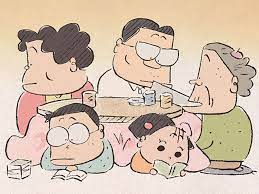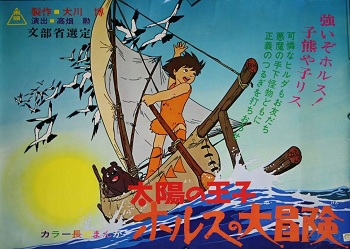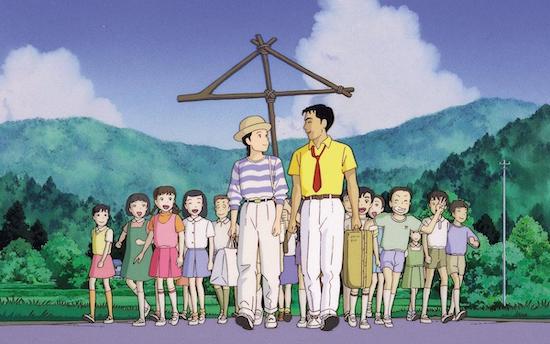Takahata on Miyazaki
July 19, 2023 · 0 comments
By Andrew Osmond.

In 2008, The New Yorker ran an epic article on Hayao Miyazaki to accompany the release of Howl’s Moving Castle. Beautifully written by Margaret Talbot, it was a celebration of the director. But one criticism in it was telling, made by Ghibli’s other legendary director.
“With Miyazaki, you have to totally believe in the world of the film,” said Isao Takahata. “He is demanding that the audience enter the world he has created completely. The audience is being asked to surrender.” Takahata suggested how he differed from his onetime colleague. “I want the audience to have a little freedom.”
Next, consider a passage from Takahata’s evocative essay on Miyazaki, ‘The Fireworks of Eros,’ from the book Starting Point. Takahata writes of Miyazaki drawing his characters “passionately… in the way he believes they should exist, or that is to his ideal. He wants to save beautiful young females from trouble, he wants a middle-aged ‘pig’ to act cool, and he wants a young woman character to be so beautiful, sensible, action-oriented, and noble that he would like to suddenly embrace her.”

Takahata continues: “And (Miyazaki’s) feelings about his characters grow stronger and stronger, to the point where he finally becomes possessed by this or that young woman or monster that doesn’t resemble him in the least. The terrifying realism his characters possess is not the result of any calculated or objective observation. Even if he does incorporate his astute observation into his artwork, he remains possessed by, and fuses with, his characters – to the point where the heightened fireworks of Eros that result actually transform his ideals into flesh and blood.”
(If your Classics are rusty, Eros, or Cupid, is the god of love and sex.)
The essay was framed as Takahata’s tribute to Miyazaki; but now consider this next quotation. This one is translated in the catalogue for the Takahata exhibition in Tokyo in 2019, mounted a year after Takahata’s death. Takahata doesn’t mention Miyazaki directly; ostensibly he is talking about anime in general. Nonetheless, the link to the earlier comments is obvious.
“There is a tendency,” Takahata writes, “to drive viewers into a position where they can only align themselves with the protagonist, without objectively indicating the hero’s circumstances. The work can only be seen through the protagonist’s eyes, so the viewer will enjoy the same thrills, but will not gain an understanding of how the world works. The viewer loses the ability to judge and can only ‘forget oneself,’ without critically appraising or feeling apprehension at the protagonist’s actions in the light of the situation.”

Takahata continues, “To become one with the protagonist, to experience his or her adventure, be mentally and emotionally stimulated, empathise with his or her sincere, dedicated or admirable disposition, and admire and enjoy the world depicted on the screen; these are certainly among the joys of movie viewing. However, they are not the result of opening heart and mind to the subject matter, and are more passively experienced by riding on the rails laid down by a skilled artist. Perhaps as a result of ‘forgetting oneself,’ the viewer feels ‘healed’ or ‘has a good cry’ or ‘feels encouraged,’ but the film is hardly effective as image training for the real world, for assessing the surrounding environment and living strongly and wisely.”
I’ll add something I was told by a Japanese friend who works in visual media. He once saw Takahata at a public event, and heard his comments. Takahata was talking about Miyazaki’s film Kiki’s Delivery Service. At that film’s climax, in the middle of a thrilling crisis, Kiki regains her flying powers in the nick of time. But why, Takahata asked, was Kiki able to regain her powers? The answer, he said, was because the audience wanted it to happen. Takahata made clear that he disapproved of such a nakedly crowd-pleasing ploy, though he added he could forgive it in his friend’s film.

Taken all together, these comments amount to an eloquent, measured and courteous critique of a director’s oeuvre. Moreover, it’s a critique by a fellow director who might credibly claim to understand Miyazaki’s work better than anyone else in the world – possibly including Miyazaki himself. Even for fervent lovers of Miyazaki’s anime, Takahata’s comments amount to an exquisite piece of devil’s advocacy. They may also help explain how Miyazaki and Takahata ended up as such different directors at Ghibli, after spending the 1960s and 1970s as tight-knit colleagues.
Takahata said that Miyazaki is “possessed” by his characters; he also implied that Miyazaki’s audience can only align itself passively with the protagonists. Takahata, meanwhile, strove to complicate that relationship. Some of his films have no protagonist. That’s the case in My Neighbours the Yamadas, where the title family is treated as a loose ensemble, with no one character allowed to dominate. It’s even more pointedly the case in Pom Poko, where the viewer spends the early scenes waiting for one of the tanuki characters to emerge as the film’s hero… and that never happens.
In parts of Grave of the Fireflies, you do strongly identify with the lead, the boy Seita. That identification is especially powerful in the early sequence where he flees through the burning Kobe; the scene was partly inspired by Takahata’s own wartime memories. But as the story continues, viewers can’t help but question Seita’s rash choices. We start to look at him from the outside, as he steers himself and his sister towards destruction. That’s helped by one of the film’s boldest devices, to reveal at the outset that both children will inescapably die. At the end, the ghost Seita seems to look out at us, the modern audience. Perhaps he’s asking, who are we to judge what he did in a time of horror and suffering? Could we have done better?

Takahata’s first film, 1968’s The Little Norse Prince, can seem much simpler. Some pundits mistake it for a mere prototype for Miyazaki adventure films such as Princess Mononoke. And yet, at its midpoint, Takahata deftly shifts its central perspective, from the hero boy Hols to the treacherous, ostensibly demonic girl Hilda, who means to undermine and slay him. This is another incredibly bold move, sliding the viewpoint from the passionate hero to a despairing girl for whom all heroics are a useless struggle against death (though the happy end is a Disneyesque cheat).
Takahata’s last film, The Tale of the Princess Kaguya, might seem to break the mould. Certainly we’re in full sympathy with Kaguya, who’s Disneyesque both in her exquisite character animation and her resistance of adult authority, a la Ariel or Mulan. But Takahata also puts a huge amount of attention on her adoptive human father, whom we’re led to see both as a greedy opportunist, exploiting her daughter’s magic and beauty, and as a loving, loveable parent.
In 2015, I was in a group press interview with Takahata in Paris, and the father’s ambiguous nature came up. “This is something that is difficult for me to comment on,” Takahata said. “It is for the viewers to comment. I’m just depicting reality as it is… I’m not choosing one direction above the others. I guess it’s a good thing that there’s this freedom of interpretation… It’s an important matter.”

Takahata’s relationship with the Kaguya story actually goes all the way back to the 1960s, when he set out his thoughts on a possible animated version by Toei (not made.) As described in this blog’s review of the Takahata exhibition, even back then Takahata questioned the straightforward anime protagonist. In one of his outlines, Kaguya would not even exist, being a non-existent object of men’s desire. In another, Kaguya would madden her father, an artist who’ll never create anything to match her beauty. At the end, he stabs her; she dies, an enduring artwork.
Takahata’s actual Kaguya film is far less radical, but his use of the father sets it apart from Miyazaki. Another father is deployed in Takahata’s 1981 comedy Chie the Brat. This is about a tomboy girl on Osaka’s Skid Row (the film’s profiled on this blog, and I reviewed it for Anime News Network). Takahata uses the interplay between Chie and her deadbeat dad to make witty jokes on masculinity. There’s a central scene where the dad’s appalled to find Chie playing at being girly, and a whole thematically-linked plotline about cats, castration, and testicles. Just by showing Chie’s different faces – a tomboy with her dad, girly with her mum – Takahata makes us regard her in a more nuanced way.
Similarly, Only Yesterday depicts the protagonist, Taeko, at contrasting times of her life – a lively elementary schooler in the 1960s, and a subdued, introspective woman remembering that childhood. The approach recalls Takahata’s 1979 TV version of Anne of Green Gables. It’s a rare anime that shows someone growing up, traced from a skinny eccentric waif to an adult who can guide children like her past self. Anne’s early episodes excel at balancing the girl’s intoxicating make-believe with the worried exasperation of her adult guardian, Marilla. Once more, Takahata uses an adult to offset the world of the child.

Of course, Takahata is hardly the only anime creator to complicate a viewer’s identification with a protagonist, or to encourage reflection. I’d argue that even the populist films of Makoto Shinkai can do that subtly, while it was practically the manifesto of the original Gundam, encouraging you to root for mutual enemies. Then there are the anime which spend hours getting viewers invested in heroes, or in engaging anti-heroes, before having those protagonists do something truly atrocious. Of course, that’s now just as common in live-action series, and I suspect Takahata would have deplored the practice as cheap, cynical melodrama.
But we started with Takahata’s critique of Miyazaki, and his comment, “I prefer the audience to have a little freedom.” We’ve seen how Takahata puts his ideas into his work, but a question remains; is Miyazaki so different?
Certainly it’s true that Miyazaki often seems entranced with his protagonists, and wants us entranced as well. Patrick W. Galbraith, author of Otaku and the Struggle for Imagination in Japan, links this to Miyazaki’s famed confession about how he got into anime in the first place. On Miyazaki’s account, it was because he “fell in love” as a student with an anime heroine – Bai-Niang in 1958’s Hakujaden.

And yet, Miyazaki’s protagonists don’t carry their films as entirely as Takahata suggests. For one thing, there’s Miyazaki’s tradition of fascinating “older women” characters. They don’t function quite like Takahata’s adults – they’re usually in adventure stories, and as Takahata notes, they’re fairly idealised themselves. But they’re often matched meticulously to a Miyazaki heroine, and not just as foils. They give an implicit commentary on the leads; indeed, they feel like the leads’ alternative selves. In short, they represent some of the freedom and distance that Takahata wants so much.
Running though Miyazaki’s films, there are the pairings of Fujiko and Clarisse; Kushana and Nausicaa; Dola and Sheeta; Ursula and Kiki; Gina and Fio; Eboshi and San; and the young and old Sophies in Howl’s Moving Castle. Even Chihiro is guided by the sassy, streetwise Lin in Spirited Away, and Ponyo by the intrepid, daring mum Lisa.
And then there’s The Wind Rises, an extraordinary hybrid. On the one hand, Miyazaki’s impulse to create characters according to his ideals is fully evident. In the Kanto Earthquake sequence, Jiro effectively becomes Ashitaka from Princess Mononoke, saving women nobly from a disaster – a disaster, incidentally, that Takahata would have shown a hundred times as harrowingly. And yet, what is Wind Rises but Miyazaki’s bid for Takahata-style objectivity? It shows a lead with blinkers far deadlier than Seita’s in Fireflies. Seita must cremate the sister he failed to save; Jiro in Wind Rises contemplates a country ablaze, never registering how he fuelled the conflagration.
Miyazaki’s new film is called How Do You Live? The name sounds more like a Takahata film than a Miyazaki one, suggesting viewers look in themselves for the answer – or to the overseas release title, the much more on-the-nose The Boy and the Heron. Will an idealised Miyazaki protagonist steer passive viewers to the answer instead? We’ll know soon enough.
Andrew Osmond is the author of 100 Animated Feature Films.
Leave a Reply